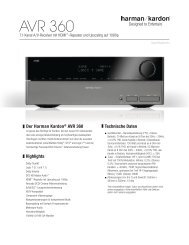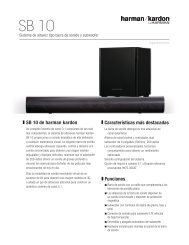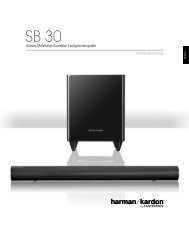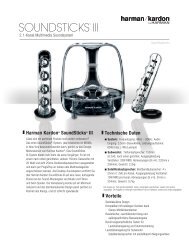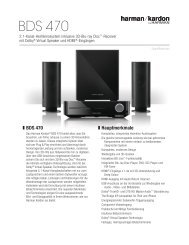Owner Manual - AVR 158 (English EU) - Harman Kardon
Owner Manual - AVR 158 (English EU) - Harman Kardon
Owner Manual - AVR 158 (English EU) - Harman Kardon
You also want an ePaper? Increase the reach of your titles
YUMPU automatically turns print PDFs into web optimized ePapers that Google loves.
<strong>AVR</strong> <strong>158</strong><br />
10<br />
Introduction to Home Theatre<br />
this introductory section will help you to familiarise yourself with some basic concepts<br />
unique to multichannel surround-sound AVrs, which will make it easier for you to set<br />
up and operate your AVr.<br />
Typical Home Theatre System<br />
A home theatre typically includes an audio/video receiver (AVr), which controls<br />
the system and supplies amplification for the loudspeakers; a disc player; a source<br />
component for television broadcasts (cable box, satellite dish AVr, hdtV tuner or aerial<br />
connected to the tV); a tV or video display; and multiple loudspeakers.<br />
Multichannel Audio<br />
the main benefit of a home theatre system is its ability to produce “surround sound.”<br />
Surround sound uses multiple speakers and amplifier channels to immerse you in the<br />
audio/video presentation for a dramatically increased sense of realism.<br />
Your AVr can have up to five main speakers connected directly to it, plus a subwoofer.<br />
each main speaker is powered by its own amplifier channel inside the AVr. A system<br />
with more than two speakers is called a multichannel system. the different main<br />
speaker types in a home theatre system are:<br />
• Front Left and Right: the front left and right speakers are used as in a two-channel<br />
system. In many surround-sound modes, these speakers are secondary, while the<br />
main action, especially dialogue, is reproduced by the centre speaker.<br />
• Centre: when you are watching movies and television programs, the centre speaker<br />
reproduces most of the dialogue and other soundtrack information that occurs on the<br />
screen, anchoring it with the picture. when you are listening to a musical program, the<br />
centre speaker helps to create a seamless front soundstage, creating a more realistic<br />
“you-are-there” listening experience.<br />
• Surround Left and Right: the surround left and right speakers produce ambient<br />
sounds that help create a realistic and immersive surround-sound environment. they<br />
also help recreate directional sound effects such as aircraft flyovers.<br />
Many people expect the surround speakers to play as loudly as the front speakers.<br />
Although you will calibrate all of the speakers in your system to sound equally loud<br />
at the listening position, most artists use the surround speakers for ambient effects<br />
only, and they create their programs to steer relatively little sound to these speakers.<br />
• Subwoofer: A subwoofer is designed to play only the lowest frequencies (the deep<br />
bass). It augments smaller, limited-range main speakers that are usually used for<br />
the other channels. Many digital-format programs, such as movies recorded in dolby<br />
digital, contain a low-frequency effects (lFe) channel that is directed to the subwoofer.<br />
the lFe channel packs the punch of a rumbling train or airplane, or the power of an<br />
explosion, adding realism and excitement to your home theatre. Some people use two<br />
subwoofers for additional power and for even distribution of the sound.<br />
Surround Modes<br />
there are different theories as to the best way to present surround sound and to distribute<br />
the individual channel information to the surround-sound system’s speakers. A variety<br />
of algorithms have been developed in an effort to recreate the way we hear sounds in<br />
the real world, resulting in a rich variety of options. Several companies have developed<br />
different surround-sound technologies, all of which can be accurately reproduced by<br />
your AVr:<br />
• Dolby Laboratories: dolby truehd, dolby digital plus, dolby digital, dolby digital ex,<br />
dolby pro logic II.<br />
® • DTS : dtS-hd high resolution Audio, dtS-hd Master Audio , dtS, dtS 96/24 .<br />
• HARMAN International: logic 7, hArMAn virtual speaker, hArMAn headphone.<br />
• Stereo Modes: two-channel stereo and five-channel stereo.<br />
Appendix table A9, on page 30, contains detailed explanations of the different surroundsound<br />
options available on your AVr. digital surround-sound modes, such as dolby<br />
digital and dtS systems, are available only with specially encoded programs, such<br />
as those available via hdtV, dVd and blu-ray disc media and digital cable or satellite<br />
television. other surround modes may be used with digital and analogue signals to<br />
create a different surround presentation or to use a different number of speakers.<br />
Surround-mode selection depends upon the number of speakers in your system, the<br />
programs you are watching or listening to, and your personal tastes.<br />
Place Your Speakers<br />
Introduction to Home Theatre<br />
and Place Your Speakers<br />
determine the locations for your system’s speakers according to their manufacturer’s<br />
directions and the layout of your listening room. use the illustration below as a guide for<br />
5.1-channel systems.<br />
to create the most realistic surround-sound environment possible, you should place<br />
your speakers in a circle with the listening position at its centre. You should angle each<br />
speaker so it directly faces the listening position. use the diagram below as a guide.<br />
tV<br />
c<br />
Fl Fr<br />
Sub<br />
Sl Sr<br />
Placing the Left, Centre and Right Speakers<br />
place the centre speaker either on top of, below or mounted on the wall above or below<br />
the tV or video-display screen. place the front left and right speakers along the circle,<br />
about 30 degrees from the centre speaker and angled toward the listener.<br />
place the front left, front right and centre speakers at the same height, preferably at<br />
about the same height as the listener’s ears. the centre speaker should be no more than<br />
2 feet (0.6m) above or below the left/right speakers. If you’re using only two speakers<br />
with your AVr, place them in the front left and front right positions.<br />
Placing the Surround Speakers<br />
You should place the left and right surround speakers approximately 110 degrees from<br />
the centre speaker, slightly behind and angled toward the listener. Alternatively, you can<br />
place them behind the listener, with each surround speaker facing the opposite-side<br />
front speaker. You should place the surround speakers 2 feet – 6 feet (0.6m – 1.8m)<br />
higher than the listener’s ears.<br />
NOTE: Your <strong>AVR</strong> will sound its best when the same model or brand of<br />
loudspeaker is used for all positions.<br />
Placing the Subwoofer<br />
because a room’s shape and volume can have a dramatic effect on a subwoofer’s<br />
performance, it is best to experiment with placement so that you will find the location<br />
that produces the best results in your particular listening room. with that in mind, these<br />
rules will help you get started:<br />
• placing the subwoofer next to a wall generally will increase the amount of bass in<br />
the room.<br />
• placing the subwoofer in a corner generally will maximise the amount of bass in the<br />
room.<br />
• In many rooms, placing the subwoofer along the same plane as the left and right<br />
speakers can produce the best integration between the sound of the subwoofer and<br />
that of the left and right speakers.<br />
• In some rooms, the best performance could even result from placing the subwoofer<br />
behind the listening position.<br />
A good way to determine the best location for the subwoofer is by temporarily placing<br />
it in the listening position and playing music with strong bass content. Move around<br />
to various locations in the room while the system is playing (putting your ears where<br />
the subwoofer would be placed), and listen until you find the location where the bass<br />
performance is best. place the subwoofer in that location.



